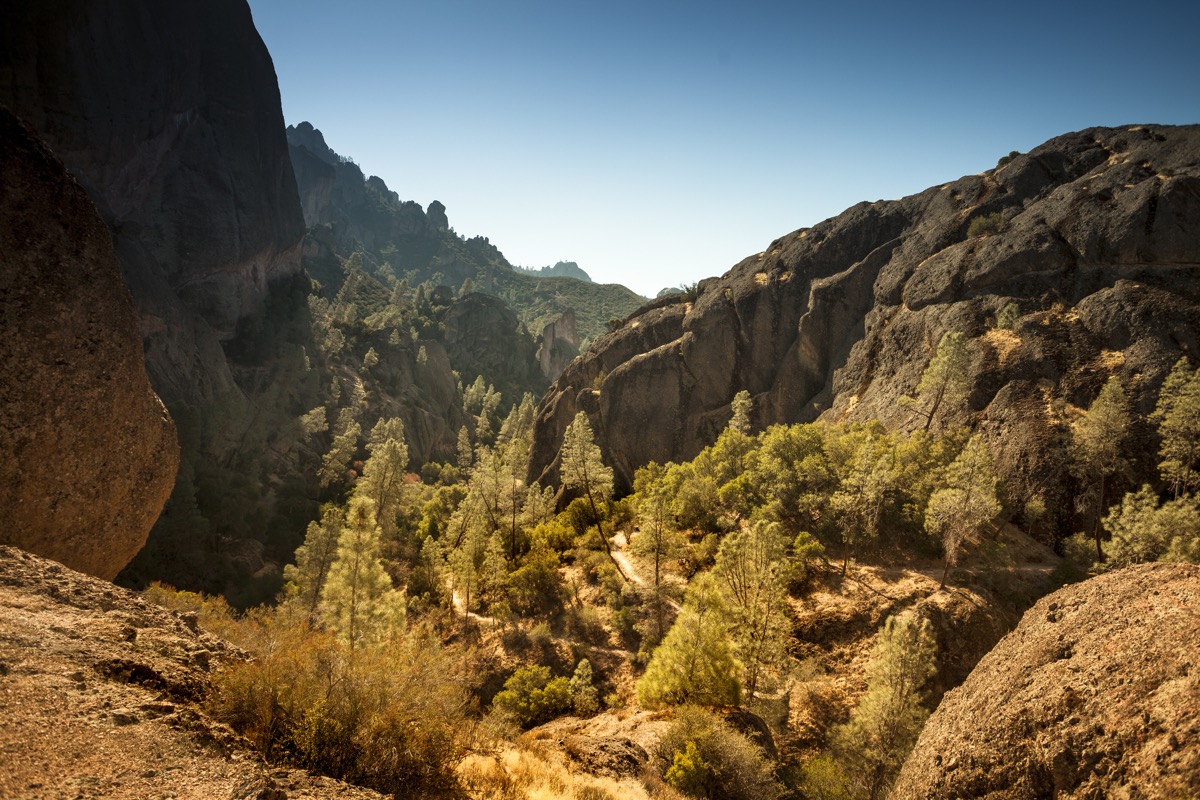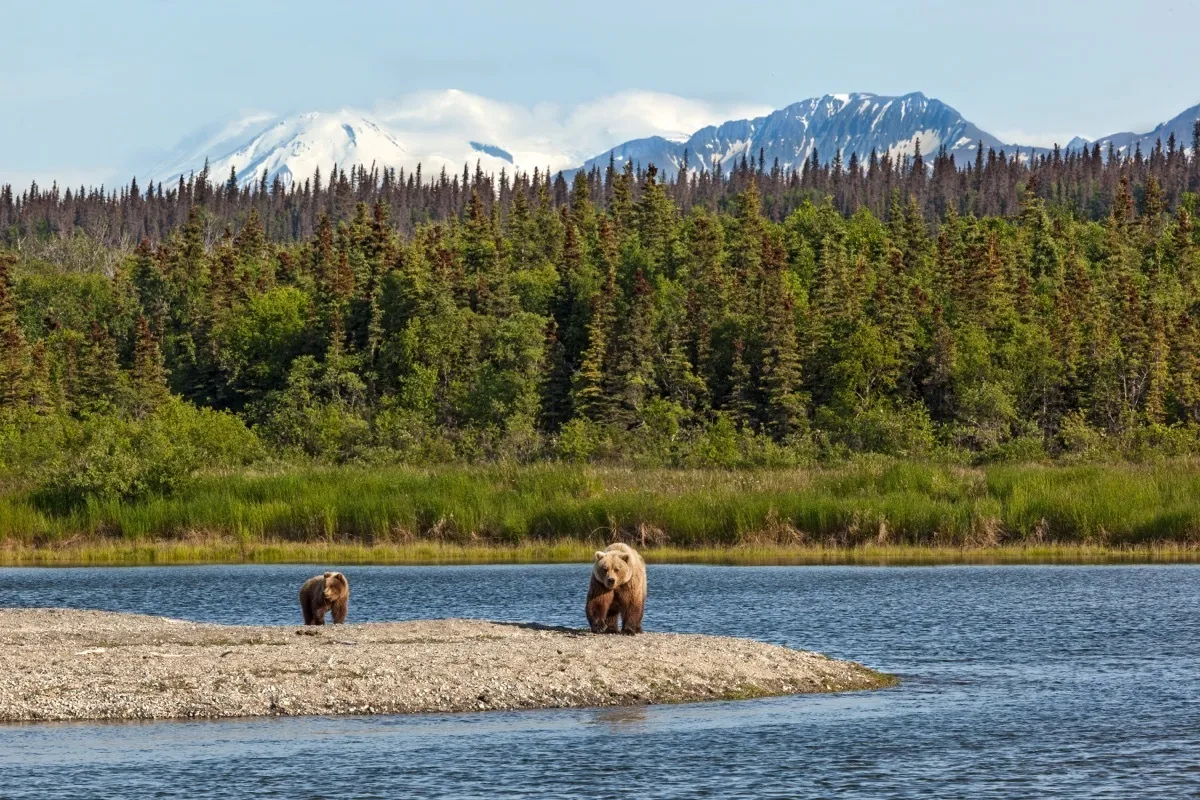The 8 Best U.S. National Parks to See Wildlife

The vast beauty of the National Park System is a massive draw for outdoor enthusiasts, from its stunning mountain vistas to its white sand beaches. But the forests, rock formations, tundras, and reefs that make up the parks are also the protected homes of some of the most unique animals in the world—including more than 600 threatened and endangered species as of 2019, according to the National Parks Conservation Association. If you’re looking to spot wildlife on your next nature trek, experts say these national parks offer the best opportunities. Read on to see which sites are home to everything from bears to bison.
READ THIS NEXT: The 5 Newest National Parks You Need to Add to Your Bucket List.
1
Grand Teton National Park

Though it may not get as much attention as its neighboring Wyoming site, Grand Teton National Park offers a relatively accessible way to catch a glimpse of its abundant wildlife.
“From the elusive moose and bears to huge herds of bison, elk, and deer, it is easy to spot wildlife by simply driving through the park,” Erin Moreland, travel blogger at Super Simple Salty Life, tells Best Life. “The best times to see these animals are sunrise and dusk.”
However, she emphasizes: “Just be sure to give them plenty of space. They may look cute, but they are wild and can become aggressive quickly!”
2
Yosemite National Park

Anyone headed into nature should be prepared to come across animals. But some national parks are so lush with creatures that it can be practically impossible to miss them—for better or worse.
“The wildlife is so abundant in Yosemite National Park that you have to take measures not to see them,” Adam Marland, travel writer and photographer for We Dream of Travel, tells Best Life. “In particular, camping rules in Yosemite are extremely rigid regarding food and trash storage due to frequent visits from coyotes, bears, squirrels, and other opportunists.”
“While even accidental baiting is monitored closely in Yosemite, there are some easy ways to maximize your opportunities for wildlife sightings. The first is to arrive in the valley very early, as this is feeding time for most animals,” he recommends. “Coyotes can often be seen bouncing around in the open field hunting mice, deer will be grazing by the rivers, and though less common, even black bears may be spotted looking for breakfast. Other critters that call Yosemite home are bald eagles, bighorn sheep, cougars (though rarely seen), and recently a Sierra Nevada red fox was spotted, which is one of the rarest and most elusive animals in the region.”
3
White Sands National Park

Travelers looking to spot animals in the wild likely think of lush forests or fertile plains first when planning their excursions. But according to experts, even deserts can be a way to see some one-of-a-kind creatures.
“White Sands National Park in New Mexico has some of the most unique wildlife that can only be found in this park,” Dave Martirosian, founder of HikersDaily, tells Best Life. “Over hundreds of years, the various creatures living there have actually changed color and turned white to better camouflage in the bleached environment of White Sands. These include lizards, snakes, scorpions, spiders, beetles, and more.”
4
Rocky Mountain National Park

Not all trips into nature have to involve a lengthy excursion. In fact, some national parks are relatively accessible while still being full of wildlife.
“Colorado’s own Rocky Mountain National Park is an easy drive from Denver,” Nate Axvig, traveler and founder of Scandinavian clothing company Aktiv, tells Best Life. “There, you are likely to see bighorn sheep and moose noshing away on mountainsides while also spotting a wide variety of birds of prey like eagles and hawks cruising around looking for lunch.”
5
Pinnacles National Park

Even as one of the newest additions to the National Park System, Pinnacles National Park is famed for the unique prehistoric volcanic rock formations that give it its name. But the site is also home to another unique animal that can be worth a trek in and of itself.
“One of my favorite bird species is the formerly-extinct-in-the-wild California Condor,” Jennifer Melroy, writer and founder of National Park Obsessed, previously told Best Life. “Pinnacles is one of the release sites for the California Condor Restoration Project. Due to this, it’s one of the best national parks to see them in the wild,” adding that a hike along the High Peaks Trail is a great place to spot the birds.
6
National Park of American Samoa

Due partly to its remote location in the South Pacific, the National Park of American Samoa is the second least-busy site in the system, with just 8,495 visitors in 2021, according to the National Park Service (NPS). But while there may not be many travelers frequenting the park, there are plenty of non-human inhabitants that make it worth a visit, with more than 900 species of fish inhabiting the coral reefs that cover the 4,000 acres of the site located underwater.
7
Yellowstone National Park

As one of the oldest, largest, and most visited national parks in the system, Yellowstone’s reputation for natural splendor tends to precede it. But besides its famous geysers and mountain vistas, the site’s 2.2 million acres are also home to 67 different mammal species, making it the largest concentration in the contiguous United States, according to Smithsonian Magazine. A visit to the park could include sightings of the park’s famed bison, herds of elk, coyotes, wolverines, grizzly bears, black bears, mule deer, mountain lions, and even gray wolves, which were reintroduced nearly 30 years ago.
8
Katmai National Park

Even though it’s the fourth largest site in the system by area, Katmai National Park is the sixth-least visited, thanks to its relatively remote location in Alaska. But visitors who do make their way there are often able to catch a glimpse of brown bears fishing for salmon at the famous Brooks Camp at Brooks Falls. Just make sure you plan well in advance if you’re heading out: The site’s visitor center is only open from June 1 through Sept. 17, and only limited support options are in place after September 30.